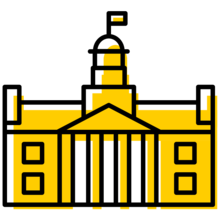
The University of Iowa is a community whose members hold various religious and philosophical views. As a public institution, we respect the separation of church and state as a constitutional principle and practice, and we hold, as one of our core values, a commitment to "vigilantly protect the free expression of thought."
Institutionally sponsored religious symbols are not appropriate in a public institution. We urge departments to be respectful of our diversity of beliefs and refrain from displaying within public areas in the workplace any religious symbols that may be seen as implying institutional support for a particular religious viewpoint. Departments should also exercise good judgment and sensitivity concerning the appropriateness of seasonal, non-religious symbols in the workplace.
Our concern about the appearance of institutional support for a particular religious viewpoint must be balanced against our respect for the rights of individuals to express religious views in their personal dress and in their personal workplaces that are not located in public areas and do not suggest institutional support.
What does this mean?
The guidelines distinguish between public areas and personal workplaces. A public area includes any university property where members of the public may come to receive services or attend public events. The following list provides a few examples of public areas:
- The lawn on the Pentacrest
- The welcome center at University Human Resources or the Cashier’s Office
- Carver-Hawkeye Arena
- The main lobby at the University of Iowa Hospitals and Clinics
- Other common spaces within colleges or units (see below)
Religious symbols should not be displayed in public spaces such as these. The university celebrates the religious diversity of our community. However, as a public institution, the university should not appear to support any particular religion.
Certain common or shared areas within work units may also be considered public spaces. These spaces are shared by more than one employee in the performance of their jobs. Such areas would include shared workstation/office space, break rooms, conference rooms, and reception areas within work units. Because these areas are shared and are not personal workspaces, religious symbols are not appropriate in these spaces.
Personal workspaces are areas occupied by a single university employee and where the public generally does not enter. Private offices or cubicles, for example, may be personal workspaces. Individual employees may exercise their right to express their religious views and display religious symbols in their personal workspaces and in their personal dress. However, if members of the university community (students, faculty, or staff) regularly enter a private office or cubicle to conduct university business, the occupant of that office must consider whether religious symbols might be viewed as implying university support for that religion.
What are religious symbols?
Any item that is linked to a particular religion is considered a religious symbol. For example, nativity sets, menorahs, the Star of David, a cross or crucifix, and images of Jesus all would be considered to be religious symbols. Evergreen trees are not considered to be religious symbols, according to U.S. Supreme Court decisions. Therefore, evergreen trees in public areas are not prohibited by the Religious Guidelines. However, an evergreen tree displayed in a public area should not be decorated with religious symbols.
Other non-religious, seasonal items that may be used to decorate workspaces during the winter months include snowflakes, wreaths, garlands, and lights. Please use good judgment in the use of such decorations so as not to disrupt the work of the unit.
Key Information
Add BMindful Holy Days to your electronic calendar
Religious Holy Days Calendar (BMindful)
Operations Manual 22.10 Religious Diversity and the University Calendar
